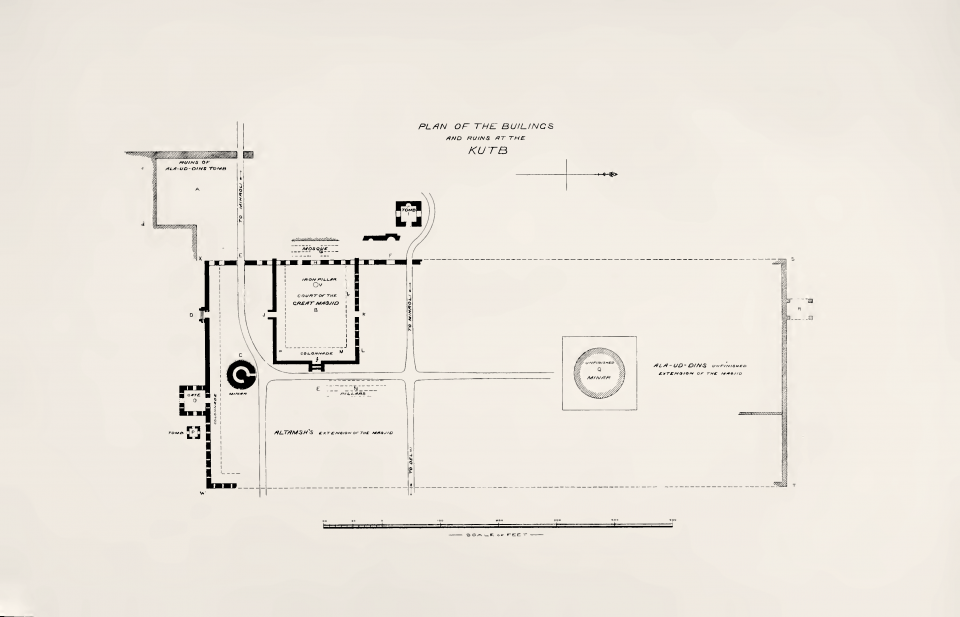THIS view was taken from the east of the Minar, and includes the two first bands of inscription, the lower one being cut into the surface of the stone, whilst the upper one is raised about two inches above it. The former circumstance is cited as a reason hi favour of the Hindu origin of the column, it being held that the Muhammadans found the pillar built up to a certain height, and were obliged to mscribe the first band of inscription and arabesque. The character of the ornament in the lower band closely resembles the ornament on the middle gateway of the Masjid built by Kutb-ud-din. The foliation in both is rounded; vide the casts of carvings of the lower band of the Minar and of a portion of the ornamental inscription from Kutb-ud-din's Gateway in the Kensington Museum. The ornament used by Shams-ud-din in continuing the budding is of an incised character, the outer surface remaining smooth and uncarved, while that prepared by order of Kutb-ud-din was carved in more direct imitation of natural forms. It would appear that Shams-ud-din altered the mode of decoration at the period of continuing the budding and preferred the raised bands, which are certainly more effective and produce a more marked contrast of light and shade.
The lower part of the first band is ten feet from the plinth and is four feet in width; the second band, above, is five feet wide and twenty feet from the top to the plinth. The bell feature occurs in the upper and lower borders of the latter, and the ornamental bands next to these borders are composed of a series of contiguous rosettes. Both features are often to be seen in Hindu temples, so that the Hindu masons employed by the Pathans were permitted to introduce some of their native designs. That the masons were Hindu may be gathered from the horizontal mode of construction in all the Kutb buildings. The mutilation of the letters in the lower band may have been caused by the crushing weight of the super-structure, evidence of which is to be seen in all parts of the basement. The ornament on the raised portions is less liable to the crushing, and has remained in a more perfect condition.
There is a portion of a still lower band about six feet from the ground, near the entrance door, which in the various repairs has not been repeated all round the column. A few Arabic words still exist, which Syud Ahmed renders, "Fuzl son of Abul Muali high priest " and the name, if anything, furnishes additional evidence in favour of the Muhammadan origin of the pillar.
On the left of the photograph is a part of the colonnade, which surrounds the Masjid, as enlarged by Altamsh (see X, W. on Plan No. II.). The columns are all plainconsisting of two detached shafts, a cap and base. These have the appearance of having been originally made to be fitted together, as they now appear and they not impossibly still hold their original position. On the left is the south-east corner of the outer wall of the Great Mosque. I obtained a cast of a part of the ornament on the tower just above the first inscription—it measures about two feet by three feet six inches—and has been deposited in the South Kensington Museum, as a representative piece of ornamental carving of the time of Kutb-ud-din-Aibik, about A.D. 1193. The original portion is situated on the west of the entrance doorway—the cornice of which is just visible in the photograph on the right.
The first band of inscription is almost illegible (see page 79), the second speaks in terms of praise of Muzuffur-Moiz-ud-din Muhammad Bin Sam (see page 80).

